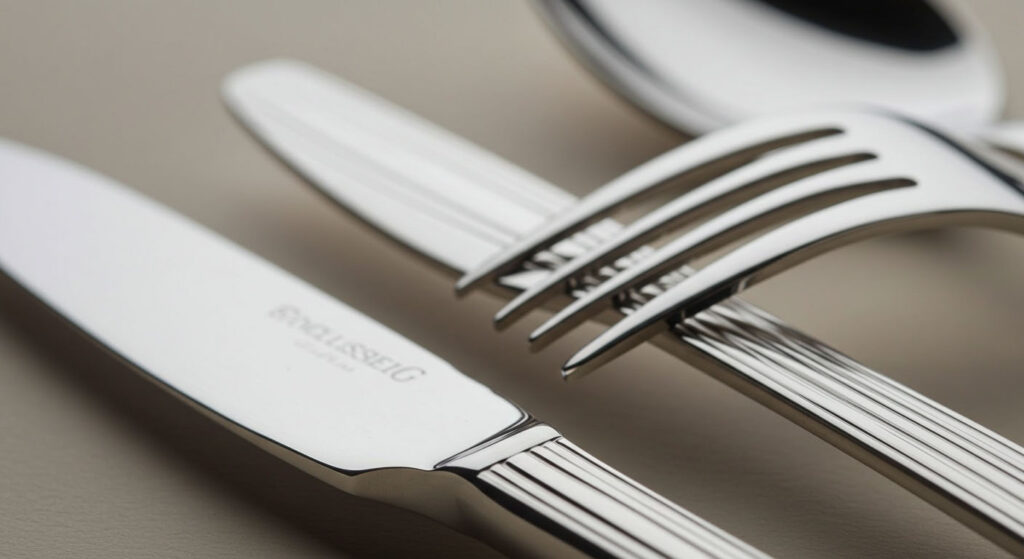What is the difference between flatware, silverware and cutlery?
Confusing flatware, silverware, and cutlery? Using the wrong term sounds unprofessional and can risk miscommunication with global partners. Let's define each one so you can speak with authority.
Cutlery often refers to knives and cutting tools. Flatware describes flat utensils like forks, spoons, and knives. Silverware traditionally meant silver items but now often refers to any fine dining set. Regional usage varies, with cutlery common in the UK and flatware/silverware in the US.

You now have the basic definitions, but the real challenge is applying them in the business world. As a factory owner, I see these words used differently across cultures every single day. My American clients, like Jacky, a seasoned procurement manager for a major brand, have very different habits from my partners in the UK. Getting this right isn't just about vocabulary; it's about building trust and ensuring a smooth supply chain. Misunderstanding these terms can lead to incorrect orders and costly mistakes. Let's dig deeper into how these words are used in the real world.
Do Americans say cutlery or silverware?
Talking to a US buyer and unsure what term to use? Using "cutlery" might confuse them. Let's clarify American usage so your communication is always precise and professional.
In the United States, "silverware" is the most common everyday term, even for stainless steel sets. "Flatware" is also widely used, especially in retail and professional settings. "Cutlery" is understood but is used far less frequently, often referring specifically to kitchen knives.

I learned this lesson early in my career. I was on a call with a new buyer from a US department store and kept referring to my knife, fork, and spoon products as "cutlery." There was a brief, confused silence. My contact, Jacky, later explained it to me. To an American ear, "cutlery" primarily brings to mind a block of kitchen knives, not the utensils you eat with. This small difference in language can create a huge barrier to clear communication.
Everyday Language: "Silverware"
In day-to-day American life, "silverware1" is king. People talk about putting the silverware on the table or washing the silverware. This term is a holdover from a time when silver-plated sets were the standard for a nice home. The name stuck, even as stainless steel became the dominant material.
Industry Language: "Flatware"
When Jacky sends me a purchase order, he uses the term "flatware." This is the more technical and commercial term in the US. It accurately describes the product category for retail, manufacturing, and logistics. It's the professional's choice.
Regional Usage at a Glance
| Term | Primary Meaning | Common Regions |
|---|---|---|
| Silverware | Any eating utensils (colloquial) | United States, Canada |
| Flatware | Forks, spoons, knives (technical) | United States, Canada |
| Cutlery | All eating utensils (common) or just knives | UK, Australia, New Zealand, Ireland |
Knowing these distinctions is crucial. When I speak with Jacky, I use "flatware." When I talk to my partner in London, I use "cutlery." It shows I understand their market.
What qualifies as flatware?
Is a soup ladle flatware? Is a steak knife? This ambiguity can complicate orders and inventory. Let's precisely define what qualifies as flatware in the industry.
Flatware specifically refers to eating utensils that are relatively flat, such as forks, spoons, and table knives. The term is used to separate these items from "holloware," which includes three-dimensional items like bowls, cups, and plates. Serving utensils can also be considered flatware.

In my factory, the distinction between "flatware2" and "holloware3" is fundamental. It defines our production lines and how we categorize inventory. Flatware is made from stamping or forging flat sheets of metal. Holloware, like a bowl or a pitcher, is formed or spun into a concave shape. It's a completely different manufacturing process.
Core Components of Flatware
When we talk about a standard flatware set, we're talking about the essentials. These are the items that almost every set includes:
- Dinner Knife
- Dinner Fork
- Dinner Spoons (or Soup Spoons)
- Dessert Fork
- Dessert Spoon
The Gray Area: Serving Utensils
Larger serving pieces are also classified as flatware because they are generally flat. This includes items like:
- Serving Spoons and Forks
- Cake Servers
- Butter Knives
- Soup Ladles
Why the Distinction Matters
When a client like Jacky requests a quote for a 50,000-piece "flatware" order, I know he means forks, spoons, and knives. If he needed matching gravy boats or serving bowls, he would list "holloware" items separately. This prevents massive confusion in quoting, production, and shipping. Creating a clear packing list that separates these categories is one of the simplest ways we avoid logistical errors. Understanding this term is essential for anyone in the business of buying or selling tableware.
What do restaurants call silverware?
Ever wonder why restaurant staff call their stainless steel utensils "silverware"? It can be confusing for suppliers. Let's clarify what this term means in the industry.
Restaurants overwhelmingly use the term "silverware" to refer to their forks, knives, and spoons, even when they are made of stainless steel. It has become a generic industry shorthand for all eating utensils. The terms "flatware" or "cutlery" are rarely used in daily restaurant operations.

This is another area where industry jargon differs from technical specifications. When a restaurant manager calls me to place an order, they might say, "I need more silverware for my tables." They are not looking for actual silver. They are talking about durable, high-volume stainless steel flatware.
A Holdover from History
The term is a direct link to the golden age of dining, where fine restaurants prided themselves on their polished sterling silver services. The name "silverware" conveyed a sense of quality and occasion. As restaurants switched to practical and cost-effective stainless steel in the 20th century, the name simply carried over. It was easier to keep using a familiar term than to retrain generations of staff.
Operational Shorthand
In the fast-paced environment of a restaurant, "silverware" is quick and easy to say. "Rolling silverware" (wrapping a knife, fork, and spoon in a napkin) is a universal side-duty for servers. It's language born from practicality.
What This Means for Suppliers
As a supplier, my job is to translate. When a restaurant client says "silverware," I understand they mean "commercial-grade stainless steel flatware." I'll then ask the important follow-up questions: "Are you looking for 18/0 or 18/8? What kind of finish?" This is where professional knowledge bridges the gap between everyday language and the technical details needed for a successful order.
What is the highest quality flatware?
Searching for the best flatware can be overwhelming. A poor choice can rust or bend, ruining your brand's reputation. Let's look at the material grades that define true quality.
The highest quality stainless steel flatware is 18/10, which contains 18% chromium and 10% nickel for maximum rust resistance and shine. Traditionally, the most luxurious option is sterling silver, but 18/10 stainless steel is the modern standard for premium, durable flatware.

The question of "quality" is something I discuss with every client. For a brand like Jacky's, which sells to discerning customers, quality is non-negotiable. While traditional sterling silver is technically a luxury material, it's not practical for modern life. It tarnishes easily and is very soft. For this reason, the conversation about the highest quality flatware today is centered on stainless steel.
The Modern Standard: 18/10 Stainless Steel
This is the gold standard for a reason. The 18% chromium4 provides excellent hardness and durability, while the 10% nickel5 content provides superior protection against corrosion and a brilliant, silver-like luster. It feels heavy and balanced in the hand and will last for decades without rusting or staining. It's the material of choice for fine dining restaurants and premium retail brands.
Why 18/10 is the Professional's Choice
Let's compare the options. While 18/0 is a decent, budget-friendly choice, it lacks the nickel that prevents spotting and rust over time. Sterling silver is beautiful but is a high-maintenance heirloom.
| Material | Key Benefits | Drawbacks |
|---|---|---|
| 18/10 Stainless Steel | Maximum rust resistance, brilliant shine, durable, dishwasher safe | Higher cost |
| 18/0 Stainless Steel | Affordable, strong, magnetic (for some uses) | More prone to staining and rust |
| Sterling Silver | Highest intrinsic value, status symbol | Tarnishes easily, very soft, extremely expensive |
For brands focused on performance and customer satisfaction, 18/10 stainless steel is the clear winner. It offers the luxurious look and feel of traditional silverware with the unbeatable durability required for modern life. It's the smart investment for lasting quality.
Conclusion
Though often used interchangeably, "cutlery," "flatware," and "silverware" have distinct meanings. Understanding these nuances is key to clear communication with global partners in the tableware industry.
-
Exploring the history of silverware reveals its evolution and significance in American culture, enhancing your understanding of dining traditions. ↩
-
Understanding flatware is crucial for grasping the production processes in metalworking. Explore this link to deepen your knowledge. ↩
-
Holloware represents a unique manufacturing process. Discover more about its significance and applications in the industry. ↩
-
Explore how 18% chromium enhances hardness and durability in various applications, making it a preferred choice in many industries. ↩
-
Learn about the role of 10% nickel in providing superior corrosion protection, essential for long-lasting materials. ↩
